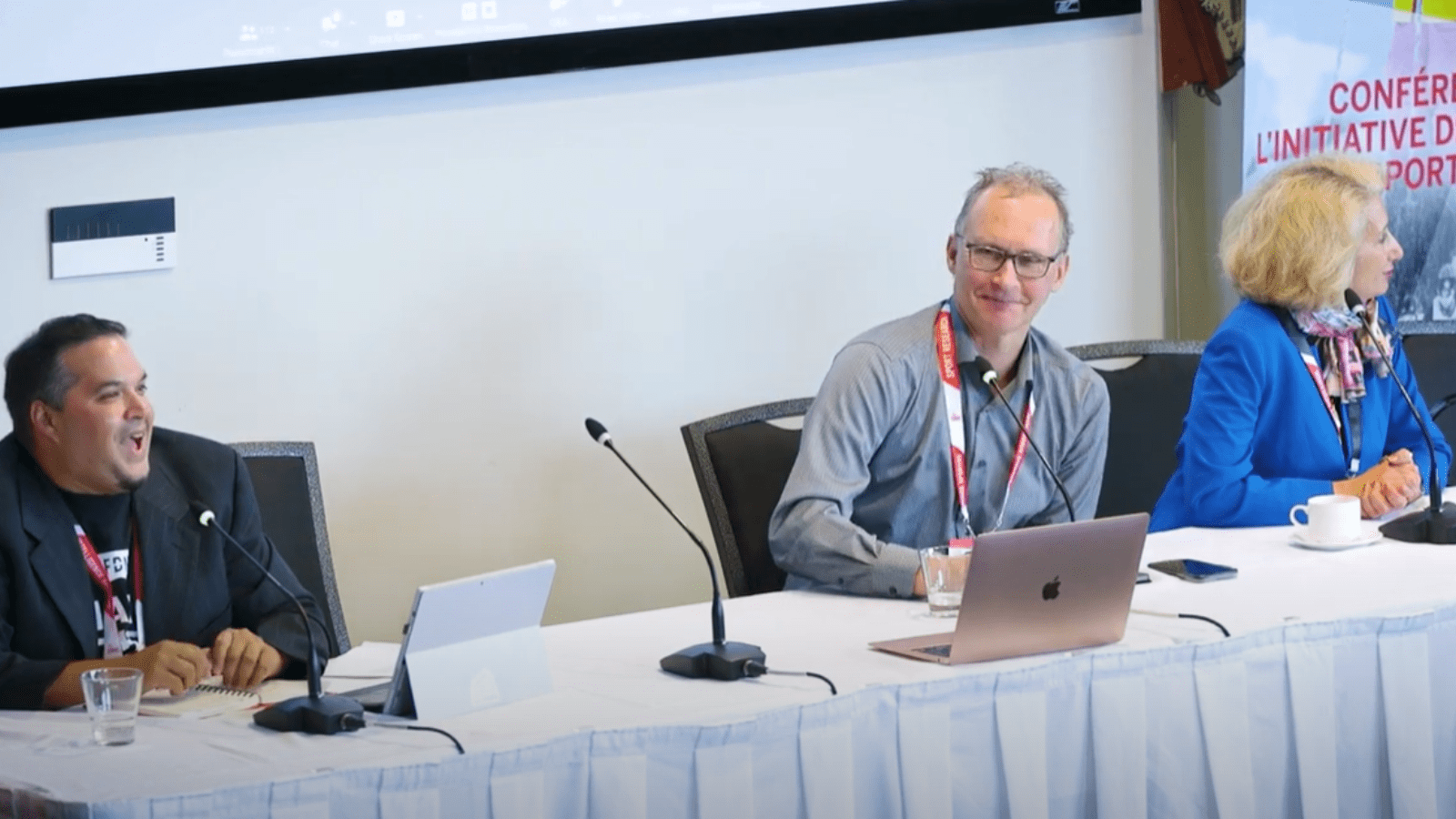Community Sport
Community sport plays a vital role in bringing people together, promoting physical health, and fostering social connections. Explore resources that support local programs, and encourage participation across all ages and abilities.
Search Community Sport Resources
Top 10 resources
- Policy Framework for Recreation in Canada
- Long Term Athlete Development Model
- SIRCuit Article: Leveling the playing field: Accessibility in youth basketball
- SIRC Article: Schools play a key role in supporting youth physical activity
- SIRCuit Article: Taking Action: Community Sport Organizations and Social Responsibility
- SCRI Panel: Trending topics in youth sport
- SIRCuit Article Building Capacity in Community Sport Organizations
- SIRCuit Article: Giving Due Deliberation to Masters Athletes: The Time has Come
- Power of Sport: The True Sport Report 2022
- SCRI Keynote: Punching above our weight – The balance is better journey of culture change in New Zealand Aotearoa

Featured resource
Patti Millar, University of Windsor

Featured resource
University of Sherbrooke and SIRC


Featured resource
SIRC and Queen's University
Quick Facts
What is community sport?
Community sport refers to organized physical activities that take place within a local community and are accessible to people of all ages, skill levels, and backgrounds. These activities are typically non-competitive or recreational and are designed to promote health, social interaction, and community engagement.
They are often organized by local clubs, schools, recreational centers, or community groups and can include a wide range of activities such as youth soccer leagues, adult basketball games, swimming lessons, and fitness classes. The focus is on participation, enjoyment, and fostering a sense of belonging within the community.
What are the benefits of participating in community sport?
The benefits that contribute to individual well-being, social cohesion, and overall community health include:
- Physical Health: Can improve cardiovascular health, enhances strength and endurance, and helps in maintaining a healthy weight.
- Mental Health: Can reduce stress, anxiety, and depression, and provide an opportunity for social interaction, which can improve mental well-being.
- Social Inclusion: Can foster a sense of belonging and inclusion by bringing together individuals from diverse backgrounds, building relationships and strengthening community bonds.
- Skill Development: Helps individuals develop physical skills, teamwork, leadership, and discipline, which can be beneficial in other areas of life.
- Youth Development: For young people, it can offer an outlet for energy, teaching important life skills, and providing positive role models.
- Community Engagement: Events and activities encourage volunteerism, local pride, and community spirit, contributing to a more connected and supportive community.
- Economic Benefits: Can boost local economies by attracting visitors, creating jobs, and promoting local businesses through events and activities.
How does community sport support youth development?
It plays a vital role in youth development by providing a structured environment for learning teamwork, discipline, leadership, and resilience. It also promotes healthy lifestyles and positive social interactions. Through regular participation, young people gain valuable life skills, build self-esteem, and develop a strong sense of community, which contributes to their overall growth and future success.
What is the Long-Term Athlete Development (LTAD) model?
The Long-Term Athlete Development (LTAD) framework is designed to guide the development of athletes from early childhood through to adulthood. It outlines specific stages to optimize training, competition, and recovery according to the age and development of the athlete. The stages are:
- Active Start
- FUNdamentals
- Learn to Train
- Train to Train
- Train to Compete
- Train to Win
- Active for Life
The LTAD ensures that athletes develop their skills and physical abilities at the appropriate pace, reducing the risk of burnout and injury. By emphasizing age-appropriate development and long-term progression, the LTAD model supports sustainable growth and peak performance in sports.
Video Resources
Motivational characteristics of adolescents who are dedicated to competitive sporting practices: Differences based on the type of sport and intensity of the practice
- Université du Québec à Trois-Rivières and SIRC
- 2014
Imagery Use in Children’s Leisure Time Physical Activities
- University of Windsor and SIRC
- 2013
Concussion Care Without Borders – Michael Ellis
- University of Manitoba and SIRC
- 2021
Sport for Development – Using Sport to Address Community Issues
- Ottawa Sport Council, SIRC, and Sport Matters Group
- 2018
SCRI: Aging Expectations in Physical Activity Behaviours (Part 2)
- York University and SIRC
- 2011
SIRCTalks/Exposés : Good parenting in youth sport
- University of Alberta and SIRC
- 2020
Knowledge Nuggets
knowledge nuggets
Clear language helps families access inclusive programs
The Adaptive and Inclusive Movement for Physical Activity network (AIMPA) works to improve access to sport and physical activity for children and youth with disabilities.
The Adaptive and Inclusive Movement for Physical Activity network (AIMPA) works to improve access to sport and physical activity for children and youth with disabilities. One recommendation of their research findings highlights that organizations should use clear, consistent definitions for terms like “inclusive,” “adapted,” and “accessible.” This helps families better understand opportunities and find programs that meet their needs.
knowledge nuggets
New tools from the amsterdam consensus on youth concussion
The 2023 Amsterdam Consensus Statement introduced new tools to better care for kids with concussions. The Child SCAT6 helps assess symptoms in the first 72
The 2023 Amsterdam Consensus Statement introduced new tools to better care for kids with concussions. The Child SCAT6 helps assess symptoms in the first 72 hours, while the Child SCOAT6 supports follow-up for up to 30 days. With Concussion Awareness Week coming up, these advances show progress in protecting young athletes.
knowledge nuggets
Movement consistency grows with sport experience
A review of 59 studies found experienced athletes move with less variability than beginners. These patterns were seen across many sports, tasks and skill levels.
A review of 59 studies found experienced athletes move with less variability than beginners. These patterns were seen across many sports, tasks and skill levels. For coaches, this highlights the value of focusing on quality, repeatable movement patterns during training to support skill development.
knowledge nuggets
Tackling stress can help athletes recover from injuries faster
Experts reviewing 50 years of research found stress increases injury risk and slows recovery, while mindfulness and mental skills training, like goal setting and visualization,
Experts reviewing 50 years of research found stress increases injury risk and slows recovery, while mindfulness and mental skills training, like goal setting and visualization, support faster healing and return to play. Protocols such as screening athletes for stress and connecting them with mental health support can help medical staff get athletes back to competition faster.
knowledge nuggets
Back to school, back to movement
A Canadian study found that schools can boost student activity levels with simple supports. Access to equipment during the day, partnerships with public health, and
A Canadian study found that schools can boost student activity levels with simple supports. Access to equipment during the day, partnerships with public health, and dedicated staff time all helped teens meet national physical activity guidelines. This shows how schools can set the stage for healthier, more active school years.
knowledge nuggets
Helping students build emotional awareness can start in the gym
Through the Captains & Poets program, educators use movement-based activities to teach self-leadership and social-emotional learning (SEL). By identifying their inner “Captain” (action) and “Poet”
Through the Captains & Poets program, educators use movement-based activities to teach self-leadership and social-emotional learning (SEL). By identifying their inner “Captain” (action) and “Poet” (reflection), students learn to manage emotions, build confidence, and coach themselves—skills that support mental well-being and success both in and out of sport.
knowledge nuggets
The impact of body image on youth athletes’ performance
Research conducted with nearly 1,400 youth athletes found that when they focus on how their bodies appear, known as “body surveillance,” their performance suffers. This
Research conducted with nearly 1,400 youth athletes found that when they focus on how their bodies appear, known as “body surveillance,” their performance suffers. This can mean slower reaction times and less precise movements when competing. The research urges coaches and sport leaders to reduce appearance-based pressures and shift focus toward athletes’ confidence and functional abilities.
knowledge nuggets
Teaching body image in physical education classes
A recent review highlights ways to support positive body image among teens in secondary school physical education. One effective approach includes activities like yoga or
A recent review highlights ways to support positive body image among teens in secondary school physical education. One effective approach includes activities like yoga or mindful movement that help students reconnect with their bodies. These activities can encourage self-awareness and body appreciation through movement.
More Community Sport Resources
|
|
|
|
|
|
|
|
|
|